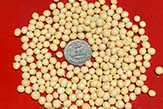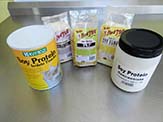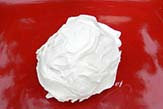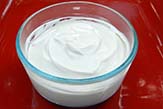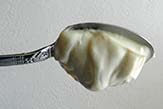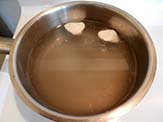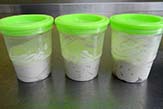Meats and Sausages
Soy Products in Sausage Manufacturing
Soy proteins are used in hot dogs, sausages, whole muscle foods, salamis, pepperoni pizza toppings, meat patties, and vegetarian sausages. Hobbyists have also discovered that adding soy protein concentrate allowed them to add more water and improved the texture of the sausage. It eliminated shriveling and made the sausage plumper. Commercially processed meats contain soy protein throughout the world. Soy proteins play a very crucial role in making reduced-fat sausages. All distributors of sausage-making equipment and supplies carry soy protein online.
Soybeans are considered to be a source of complete protein. A complete protein contains significant amounts of all the essential amino acids that must be provided to the human body because of the body’s inability to synthesize them. For this reason, soy is a good source of protein, amongst many others, for vegetarians and vegans or for people who want to reduce the amount of meat they eat. They can replace meat with soy protein products without requiring major adjustments elsewhere in the diet. Many other products are obtained from soybeans. such as soy flour, textured vegetable protein, soy oil, soy protein concentrate, soy protein isolate, soy yogurt, soy milk, and animal feed for farm-raised fish, poultry, and cattle.
| Soybean Nutrient Values (100 g) | |||||
|---|---|---|---|---|---|
| Name | Protein (g) | Fat (g) | Carbohydrates (g) | Salt (g) | Energy (cal) |
| Soybean, raw | 36.49 | 19.94 | 30.16 | 2 | 446 |
| Soybean Fat Values (100 g) | ||||
|---|---|---|---|---|
| Name | Total Fat (g) | Saturated Fat (g) | Monounsaturated Fat (g) | Polyunsaturated Fat (g) |
| Soybean, raw | 19.94 | 2.884 | 4.404 | 11.255 |
| Source: USDA Nutrient database | ||||
Soy flour is made by milling soybeans. The flour can be full-fat or de-fatted, depending on the oil extracted. It can be made as fine powder or more coarse soy grits. Protein content of different soy flours:
- Full-fat soy flour - 35%.
- Low-fat soy flour - 45%.
- Defatted soy flour - 47%.
Generally, soy flour is not added to processed meats due to its flavor profile.
Textured soy flour (TSF) is obtained from regular soy flour, which is processed and extruded to form products of specific texture and form, such as meat-like nuggets. The formed products are crunchy in the dry form and, upon hydration, become moist and chewy.
Soy Proteins
Soybeans contain all three nutrients required for good nutrition: complete protein, carbohydrate, and fat, as well as vitamins and minerals, including calcium, folic acid, and iron. The composition of soy protein is nearly equivalent to meat and milk. and egg protein. Soybean oil is 61% polyunsaturated fat and 24% monounsaturated fat, comparable to the unsaturated fat content of other vegetable oils. Soybean oil contains no cholesterol.
Soy concentrates and isolates are used in sausages, burgers, and other meat products. Soy proteins, when mixed with ground meat, form a gel upon heating, entrapping liquid and moisture. They increase the firmness and juiciness of the product and reduce cooking loss during frying. In addition, they enrich the protein content of many products and make them healthier by reducing the amount of saturated fat and cholesterol that otherwise would be present. Soy protein powders are the most commonly added protein to meat products at around 2-3% as the larger amounts may impart a “beany” flavor to the product. They bind water extremely well and cover fat particles with fine emulsion. This prevents fats from lumping together. The sausage will be juicier, plumper and have less shriveling.
Soy Protein Concentrate (SPC)
Soy protein concentrate (about 60% protein), available from most online distributors of sausage-making supplies is a natural product that contains around 60% protein and retains most of the soybean’s dietary fiber. SPC can bind 4 parts of water. However, soy concentrates do not form the real gel as they contain insoluble fiber that prevents gel formation; they only form a paste. Before processing, soy protein concentrate is re-hydrated at a ratio of 1:3.
Soy Protein Isolate (SPI)
Soy protein isolate (80-90% protein), is a natural product that contains at least 80-90% protein and no other ingredients. It is made from de-fatted soy meal by removing most fats and carbohydrates. Therefore, soy protein isolate has a very neutral flavor compared to other soy products. As soy protein isolate is more refined, it costs slightly more than soy protein concentrate. Soy protein isolate can bind 5 parts of water. Soy isolates are excellent emulsifiers of fat and their ability to produce the real gel contributes to the increased firmness of the product. Isolates add juiciness, cohesiveness, and viscosity to various meats, seafood, and poultry products. This enhances both the nutritional quality and taste of meat products.
For making quality sausages. the recommended mixing ratio is 1 part of soy protein isolate to 3.3 parts of water. SPI is chosen for delicate products that require superior flavors such as yogurt, cheese, whole muscle foods and healthy drinks. Soy protein isolates sold by health products distributors online usually contain 92% of protein.
Textured Vegetable Protein - TVP
Textured vegetable protein (TVP), also known as textured soy protein (TSP), soy meat, or soya meat, has been around for more than 50 years. It contains 50% protein, little fat, no cholesterol, and is very rich in fiber. It is an excellent filler material for ground meat and sausages. TVP is made from defatted soy flour, a by-product of extracting soybean oil, and is relatively flavorless. Its protein content is equal to that of the meat, and it contains no fat.
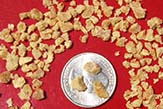
Textured vegetable protein (TVP) flakes. The quarter coin for size comparison. TVP must be rehydrated with water/liquid before use.
TVP flakes are the size of the finely ground meat having the texture and the bite of the meat. Textured vegetable protein is cheaper than meat and is used to extend meat value. It adds an unexpected bonus - the final product contains less fat and cholesterol and retains its full nutritional value.
| Textured Vegetable Protein (100 g = 1 cup) | |||||
|---|---|---|---|---|---|
| Name | Protein (g) | Fat (g) | Carbohydrates (g) | Salt (mg) | Energy (cal) |
| TVP | 50 | 0 | 30 | 8 mg | 333 |
| Source: Bob's Red Mill | |||||
Soy TVP can be used as a low cost/high nutrition extender in comminuted meat and poultry products. Textured vegetable protein provides substance and taste to low-fat meat products by imitating lean meat. Half a cup of soy TVP provides 126 calories, 25 g protein 14 g carbohydrates and 0 g fat. TVP flakes or powder are usually soaked in water (1 part of flakes to 2 parts of water) and then mixed with minced meat to a ratio of up to 1:3 (re-hydrated TVP to ground meat). TVP has no flavor and is practical to use as a meat substitute or extender. Besides, it offers the best value for the money. You don’t necessarily need to add TVP to your healthy sausage, which consists of mostly lean meat, but lean meat such as pork loin is expensive. You may replace up to 30% of lean meat with re-hydrated TVP lowering the sausage's cost and the cholesterol level. This may be less important when only a few pounds of meat are produced.
However, when ten or more pounds of sausages are made to meet the needs of a large family, the savings are substantial. TVP is a great ingredient for making vegetarian foods. TVP is made from high (50%) soy protein, soy flour or concentrate, but can also be made from cotton seeds, wheat, and oats. It is extruded into various shapes (chunks, flakes, nuggets, grains, and strips) and sizes, and is primarily used as a meat substitute due to its low cost. When a TVP enriched meat product is cooked, it loses less weight as TVP absorbs meat juices and water that would normally be lost.
The small granules of TVP are easy to rehydrate, but warm water can improve hydration. However, the mixture must be cooled before being blended with minced meat. Rehydrated TVP must be refrigerated and treated like meat. Usually, 1 part of textured soy protein will absorb 2-3 parts of water. Rehydrating TVP at a 2:1 ratio, drops the percentage of protein to an approximation of ground meat at 16%. TVP can be mixed with ground meat to a ratio of up to 1:3 (re-hydrated TVP to meat) without reducing the quality of the final product. Adding 3% re-hydrated TVP will result in a high-quality sausage. Higher levels of TVP (3-10%) may result in sausages with a decreased meaty flavor. However, up to 15% of TVP levels are accepted in burgers and patties.
| Protein rich powders, 100 g serving | |||||
|---|---|---|---|---|---|
| Name | Protein (g) | Fat (g) | Carbohydrates (g) | Salt (mg) | Energy (cal) |
| Soy flour, full fat, raw | 34.54 | 20.65 | 35.19 | 13 | 436 |
| Soy flour, low fat | 45.51 | 8.90 | 34.93 | 9 | 375 |
| Soy flour, defatted | 47.01 | 1.22 | 38.37 | 20 | 330 |
| Soy meal, defatted, raw, crude protein | 49.20 | 2.39 | 35.89 | 3 | 337 |
| Soy protein concentrate | 58.13 | 0.46 | 30.91 | 3 | 331 |
| Soy protein isolate, potassium type | 80.69 | 0.53 | 10.22 | 50 | 338 |
| Soy protein isolate (Supro®) * | 92.50 | 2.8 | 0 | 1,400 | 378 |
| Source: USDA Nutrient database * Data by www.nutrabio.com. Soy isolates sold by health products distributors online usually contain 92% of protein. | |||||
Protein Emulsions
Protein is needed to mix substances such as fat and water. Proteins are released from muscles during mechanical action such as cutting or grinding. Salt and phosphates greatly advance the release of proteins. Protein and all those particles such as salt, protein, sugar, parts of fiber, muscles, and collagen create a liquid that coats each fat particle with a thin layer of soluble protein. Those coated fat particles combine with water and meat, creating the emulsion. The leaner the meat, the more protein it contains. If little or no fat is used, there will not be real emulsion, and the proteins will hold the texture of the sausage together. Due to the high protein content (80-90%) soy protein isolate is a powerful emulsifying agent that can help to make quality liver and emulsified sausages (hot dog, bologna). To take full advantage of soy protein isolate capabilities, it should be cut in a bowl cutter (or in the food processor). Milk protein (caseinate) is another binder that promotes a strong emulsion by interacting with water and fat particles.
For sausages that will be processed using a grinder only, it is advisable to use premixed emulsion.
To make a healthier sausage animal fat can be partly or completely replaced with a vegetable oil. In such a case the protein : oil : water emulsion can be made. (How to Make Oil Emulsion)
| Binder | Binder/fat/water ratio | Average amount | Added as |
|---|---|---|---|
| Milk caseinate | 1:5:5 to 1:8:8 | 2% in relation to meat mass | Dry powder or premixed emulsion |
| Soy protein isolate | 1:5:5 | 2% in relation to meat mass | Dry powder or premixed emulsion |
| Binder | Binder/fat/water ratio | Average amount | Added as |
|---|---|---|---|
| Soy protein isolate | 1:4:5 | 5-10% in relation to meat mass | Dry powder or premixed emulsion |
In the past soy protein isolate cost twice as much as soy protein concentrate and the concentrate became an obvious choice for the majority of products. Soy protein isolate is still costlier today, but not as much, so a hobbyist’s decision will be based not on economics but on the application. Soy isolates are excellent emulsifiers of fat, and their ability to produce gel contributes to the increased firmness of the product. For these reasons, they may be chosen over soy protein concentrate for making liver and emulsified sausages.
Soy protein concentrates do not form the real gel as they contain some of the insoluble fiber that prevents gel formation; they only form a paste. This does not create a problem as the sausage batter will never be emulsified to the extent that the yogurt or smoothie drinks are.
Originally, the meat industry used soy protein concentrates and isolates to bind fat and water in meat applications and increase protein content in lower-grade sausages. They were crudely refined, and if added at above 5%, they imparted a “beany” flavor to the finished product. As the technology advanced, the soy products were refined further and exhibit a neutral flavor today. Today, soy proteins are considered not just a filler material but a “good food” and are added to processed meats all over the world. They are used by athletes in diet and muscle-building drinks or as refreshing fruit smoothies.
The dramatic increase in interest in soy products is largely credited to the 1995 Food and Drug Administration ruling allowing health claims for foods containing 6.25 g of protein per serving. The FDA approved soy as an official cholesterol-lowering food, along with other heart and health benefits. The FDA granted the following health claim for soy: “25 grams of soy protein a day, as part of a diet low in saturated fat and cholesterol, may reduce the risk of heart disease.”

